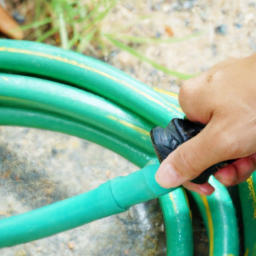Increase Garden Hose Pressure How To
Table of Contents []
- How To Increase Garden Hose Pressure
- 1. Clean Your Garden Hose of any Clogs or Grime
- 2. Increase the Width of the Hose
- 3. Upgrade Your Garden Hose's Water Pressure Regulator
- 4. Upgrade Your Garden Hose Fitting
- 5. Install a Low Pressure Garden Hose Booster Pump
- 6. Install Your Own Water Pump
- 7. Install an Inline Water Booster
- 8. Connect Your Garden Hose to an External Water Source
- Conclusion: Final Word
How To Increase Garden Hose Pressure
Tips and Tricks on Increasing Garden Hose Pressure
Controlling garden hose pressure can really be a challenge. There are many ways you can increase the pressure of your garden hose and all of these methods are relatively simple and come with added advantages. This article will cover 8 to 12 central themes based on how to increase garden hose pressure, including background, importance, applications, and potential challenges.
1. Clean Your Garden Hose of any Clogs or Grime
Having dirt, grime, or clogs in your garden hose can reduce the pressure of the water. To fix this, start by draining the water from the hose and then examine the entire length of the hose for any clogs such as plant leaves, dirt, and other debris. If you see any clogs, make sure they are removed completely. If the clogs are stubborn, try using a wire brush to clear them out. Also, check the attachment points like the sprinklers and spray nozzles to make sure they are clean as well.
2. Increase the Width of the Hose
The standard garden hose is usually inches in diameter, but you can find hoses that are wider than the standard size, such as 3/4-inch to 1-inch. The larger the diameter hose, the more water it can handle, which means higher pressure. But keep in mind that larger hoses are more expensive and more difficult to maneuver.
3. Upgrade Your Garden Hose's Water Pressure Regulator
Most garden hoses come with water pressure regulators. These regulators keep the water pressure from getting too high, which is often necessary if a sprinkler is connected to the hose. If you need more water pressure, consider upgrading the water pressure regulator or get rid of it altogether. However, keep in mind that getting rid of the regulator will increase the amount of water that is being used, so make sure you adjust your sprinkler accordingly.
4. Upgrade Your Garden Hose Fitting
The garden hose fitting determines how much water is being let through the hose and can affect the pressure. If you're not getting enough pressure from your garden hose, consider upgrading the fitting to a higher-grade fitting. This will allow for more water to flow through the hose which results in increased pressure.
5. Install a Low Pressure Garden Hose Booster Pump
A garden hose booster pump is great for increasing the water pressure of your hose. This essentially works by drawing in water from the tap and then pushing it through the garden hose, boosting the pressure. Keep in mind that this can be quite expensive, but if you need high water pressure then this is a great option.
6. Install Your Own Water Pump
If the garden hose booster pump is too expensive then installing your own water pump can be a great alternative. Installing a water pump can be quite involved, but the end result can be worth it. This is best done with the help of a professional, but the upside to having a water pump is that you will have high water pressure anytime you need it.
7. Install an Inline Water Booster
An inline water booster is best for smaller applications, where you just need a bit of added pressure such as when you're using a sprinkler or a garden hose sprayer. Basically, an inline water booster will fit between your tap and your garden hose and will increase the pressure of the water as it flows through the hose. This is a great option if you're looking for a quick fix.
8. Connect Your Garden Hose to an External Water Source
If you have access to an external water source, like a well or a stream, you can connect your hose directly to this source. This can provide much higher water pressure than what is coming from your tap. Keep in mind that this could potentially be dangerous, so make sure you're using the proper safety measures.
Conclusion: Final Word
As you can see, there are many options for increasing the water pressure of your garden hose. Whether you install a more powerful fitting, install your own water pump, or use an inline water booster, there is an option for everyone. It's just a matter of figuring out which one is right for you.

Previous Page